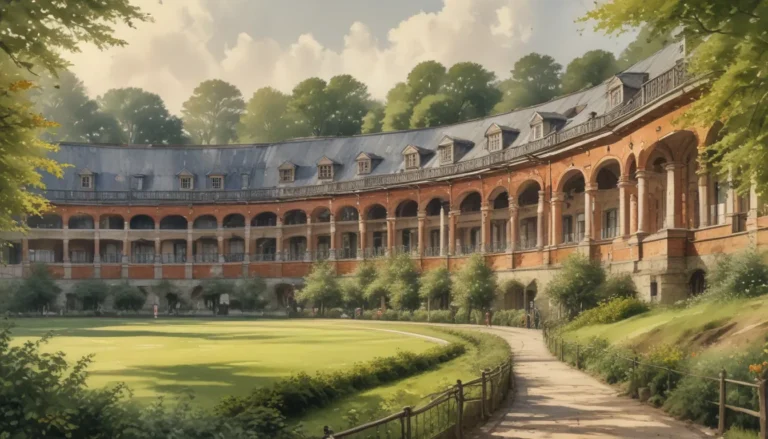The images in our articles are for illustrative purposes only and may not exactly match the content. They are intended to capture your interest and complement the text, not to replace it.
Are you ready to embark on a journey into the heart of Sri Lanka’s rich cultural and spiritual traditions? Look no further than the Temple of the Tooth, also known as Sri Dalada Maligawa, a sacred Buddhist temple located in the picturesque city of Kandy. This magnificent structure, built in the 16th century, is not only a religious shrine but also a UNESCO World Heritage site and a major tourist attraction. Home to one of the most revered relics in Buddhism—the sacred tooth of Lord Buddha—the Temple of the Tooth offers a fascinating exploration of history, architecture, and symbolism.
Let’s delve into 19 intriguing facts about the Temple of the Tooth, shedding light on its significance and the customs that make it a must-visit destination for people of all faiths.
1. A Symbol of Sovereignty
The Temple of the Tooth houses the sacred relic of the left upper canine tooth of Lord Buddha. This tooth relic is considered a symbol of sovereignty and holds immense spiritual significance for Buddhists around the world.
2. Nestled in Natural Beauty
Located in the city of Kandy, Sri Lanka, the Temple of the Tooth is surrounded by lush greenery and scenic mountains, creating a tranquil and picturesque setting for visitors to explore and experience.
3. UNESCO World Heritage Site
Recognized as a UNESCO World Heritage site, the Temple of the Tooth attracts thousands of visitors annually who come to witness its historical and cultural importance. It serves as a testament to Sri Lanka’s rich heritage.
4. Dazzling Architecture
The architecture of the temple is a stunning fusion of Kandyan, South Indian, and Indo-Chinese styles. Intricate carvings, vibrant colors, and detailed craftsmanship adorn the structure, making it a visual marvel for all who visit.
5. Protective Rituals
To safeguard the sacred tooth relic, the temple follows various protective rituals, including the grand Esala Perahera procession. This annual event features elephants, traditional dancers, drummers, and performers, creating a spectacle that captivates all who witness it.
6. A Place of Worship
Originally built by King Vimaladharmasuriya I in the 16th century, the Temple of the Tooth has been a place of worship and pilgrimage for Buddhists from across the globe, reflecting its enduring historical significance.
7. Jewel-Adorned Casket
The sacred tooth relic is enshrined within a gold casket adorned with precious gemstones, symbolizing the reverence and importance placed on this holy artifact within the temple complex.
8. Annual Lighting Ceremony
Each year, the temple hosts a breathtaking lighting ceremony known as the “Diyasalawa.” Thousands of oil lamps illuminate the entire complex, creating a magical and ethereal ambiance that enchants visitors.
9. Cultural Extravaganza
Visitors to the temple can enjoy captivating cultural performances, including traditional Kandyan dances, drumming, and devotional singing. These performances offer a deeper insight into the vibrant cultural heritage of Sri Lanka.
10. World Tooth Relic Museum
Within the temple complex lies the World Tooth Relic Museum, which showcases artifacts related to the tooth relic and its historical significance. It provides visitors with an opportunity to delve into the temple’s past and learn more about its revered relic.
11. Pilgrimage Site
Considered one of the most important pilgrimage sites for Buddhists worldwide, the Temple of the Tooth attracts devotees from near and far who come to pay their respects and seek blessings from the sacred tooth relic.
12. Elaborate Decorations
During festive occasions and religious ceremonies, the temple is adorned with intricate decorations and colorful floral arrangements, enhancing its grandeur and creating a vibrant atmosphere for worshippers.
13. The Sacred Chamber
The chamber housing the sacred tooth relic, known as the “Handun Kunama,” is a heavily guarded area accessible only to high-ranking monks and officials. This adds to the aura of sanctity surrounding the relic.
14. Daily Rituals
The custodians of the temple conduct daily rituals, including offerings of fragrant flowers, incense, and prayers to honor the sacred tooth relic. These rituals are performed in accordance with ancient traditions and customs.
15. Festival Atmosphere
During festivals and celebrations, the temple becomes a hub of activity, with devotees participating in religious processions, rituals, and traditional ceremonies that evoke a sense of devotion and spiritual fervor.
16. Custodians of the Relic
The custodians of the sacred tooth relic, known as the “Dalada Maligawa Adikarana Nilame,” hold a position of great honor and responsibility. They ensure the care and protection of the relic, preserving its sanctity for future generations.
17. Spiritual Serenity
Visiting the Temple of the Tooth offers a deeply immersive experience, enveloping visitors in a serene environment imbued with a profound spiritual aura. It provides a place of peace and tranquility for those seeking solace and reflection.
18. Global Appeal
People from diverse countries and religious backgrounds visit the Temple of the Tooth to witness not only its historical and cultural significance but also the spiritual and symbolic value it holds across different faiths. It serves as a unifying symbol of shared reverence and devotion.
19. Enduring Legacy
In conclusion, the Temple of the Tooth stands as a remarkable symbol of Sri Lanka’s cultural and religious heritage. With its rich history, architectural beauty, and spiritual significance, it continues to captivate visitors from around the world. Whether you are a history enthusiast, a spiritual seeker, or a curious traveler, a visit to this sacred temple promises an unforgettable experience that resonates with the soul.
FAQs
-
What is the Temple of the Tooth?
The Temple of the Tooth, also known as Sri Dalada Maligawa, is a sacred Buddhist temple in Kandy, Sri Lanka, housing the relic of the tooth of Lord Buddha. -
Can visitors see the actual tooth relic?
The actual tooth relic of Buddha is not publicly displayed but kept within a series of seven nested golden caskets accessible only to temple custodians. -
Is photography allowed inside the temple?
Photography inside the temple is generally prohibited, but visitors can capture the exterior and scenic surroundings of the temple. -
When is the best time to visit the Temple of the Tooth?
While the temple is open year-round, the Kandy Esala Perahera festival in July or August offers a vibrant time to witness cultural festivities and processions. -
Is there an entrance fee for the temple?
Yes, there is an entrance fee to visit the Temple of the Tooth, which varies for local and foreign visitors. It is advisable to check the current fee before planning your visit.
Embark on a journey of discovery at the Temple of the Tooth, where history, culture, and spirituality converge to create an unforgettable experience. Immerse yourself in the wonders of this sacred site and uncover the mysteries that have drawn visitors for centuries. Let the Temple of the Tooth in Kandy, Sri Lanka, be your gateway to a deeper understanding of the world’s diverse traditions and timeless wisdom.






